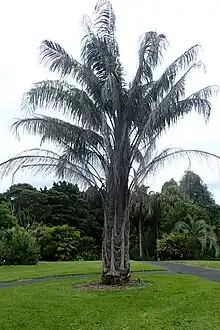Parajubaea torallyi
Parajubaea torallyi, commonly known as the palma de Pasobaya or Bolivian mountain coconut, is a species of evergreen flowering plant of genus Parajubaea, in the family Arecaceae, closely related to the coconut palm in the tribe Cocoseae.
| Parajubaea torallyi | |
|---|---|
 | |
| Scientific classification | |
| Kingdom: | Plantae |
| Clade: | Tracheophytes |
| Clade: | Angiosperms |
| Clade: | Monocots |
| Clade: | Commelinids |
| Order: | Arecales |
| Family: | Arecaceae |
| Genus: | Parajubaea |
| Species: | P. torallyi |
| Binomial name | |
| Parajubaea torallyi (C.Mart.) Burret | |
| Synonyms[2] | |
| |
It is endemic to Bolivia, where it grows in dry forests on steep rocky slopes at 2,400–3,400 metres (7,900–11,200 ft) in altitude.[1]
It is cultivated for its stunning ornamental properties united to its cold hardiness.
In cultivation it prefers a mild or cool climate without extremes of temperature and a neutral to acidic soil, and it tolerates droughts but not excess of water.
It is now an endangered species, threatened by habitat loss.[3]
Description
Parajubaea torallyi can be over 13 meters in height. It can withstand temperatures of -13 degrees Celsius (9 degrees Fahrenheit). The fruits, or cocos, grow 5–10 cm in diameter in clusters weighing up to 15 kg.[4][5]
 Parajubaea torallyi
Parajubaea torallyi Parajubaea torallyi
Parajubaea torallyi
References
- Moraes, M. (1998). "Parajubaea torallyi". IUCN Red List of Threatened Species. 1998: e.T38626A10140174. doi:10.2305/IUCN.UK.1998.RLTS.T38626A10140174.en. Retrieved 15 November 2021.
- The Plant List
- Zipcode Zoo entry Archived 5 June 2010 at the Wayback Machine
- Burret, Karl Ewald. 1930. Notizblatt des Botanischen Gartens und Museums zu Berlin-Dahlem 11: 50, Parajubaea torallyi
- Martius, Carl Friedrich Philipp von. 1847. Voyage dans l'Amérique Méridionale v 7, part 3, page 105, pl. 15, f. 3. 1834, Diplothemium torallyi (1834 being the date of the voyage, 1847 the date of the publication of the books)
